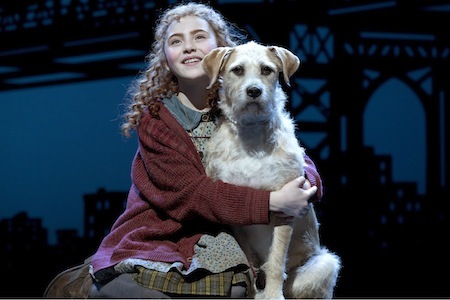Little Orphan Annie is Back and Better than Ever

Annie
Palace Theater
1564 Broadway
New York, N.Y.
The lights are back on on Broadway, where Sandy isn't a hurricane, but a dog.
It's Christmas 1933, and Franklin Roosevelt has been in office for nine months, trying everything he can to pull the nation out of the Great Depression. Nearly 40 percent of the country is out of work. The Nazis are on the march in Germany. Life is grim. At least people can drink again, but then it's not like Prohibition ever stopped that, anyway.
In New York, sour-faced Oliver Warbucks, the bald billionaire, has just returned to his mammoth Fifth Avenue mansion from a six-week tour of his factories. At the same time, a little eleven-year-old girl named Annie, a street smart tyke with blazing red hair and a smile as wide as the Empire State building, has fled from a downtown all girl orphanage run by Miss Hannigan, a badly dressed, boozy tyrant, and is trying to find her real parents. Along the journey through Depression New York, she picks up a cute stray dog, Sandy. Soon, in an odd twist of fate, Annie and Warbucks meet.
The musical Annie is back and just in time.
A revival of the smash 1977 play that earned seven Tony Awards and ran on Broadway for six years opened in New York last week. It's even better than the original, a sumptuous, fun-filled and triumphant story of the human spirit, tested so strongly in the Depression and, more importantly, right now. Annie, a lovable, spunky moppet, is a brightly wrapped Christmas gift come early for a country ravaged by the recession, foreign wars and hurricanes.
Cute little Annie assures all the downtrodden, out of work, out of power people in the audience that the sun will come out tomorrow.
In Annie, Daddy Warbucks has an orphan boy live with him each year for two weeks at Christmas as a publicity stunt. This year he is startled to have a little girl, Annie, picked by his assistant Grace Farrell, who belts out "Tomorrow" and other songs and dances her away across his football field-sized living room. She's utterly adorable and he falls head over heels in (fatherly, one hopes) love with her
Lilla Crawford is a majestic Annie. She is a bigger and older Annie than her predecessors, has a New York accent and is as brash as she is adorable. She bounces about the stage with abandon, is as casual with President Roosevelt as with the wretched Miss Hannigan and can belt out a tune with panache. She is surrounded by a bevy of other adorable orphan girls (Emily Rosenfeld, Georgi James, Taylor Richardson, Madi Rae DiPietro, Junah Jang and Tyrah Skye Odoms) who bring the house down with the memorable song "It’s a Hard Knock Life." Warbucks is played nicely by Anthony Warlow, who is tough as steel at first and then melts in Annie’s hands and becomes a real person. Katie Finneran is wonderful as the evil Miss Hannigan, drunk half the time, snarling the other half and easy to loathe in both versions. Clarke Thorell is a good Rooster, a natural street hustler who is Hannigan’s brother. Jeremy Davis is a funny Bert Healy, host of the radio variety show that features the irrepressible Boylan Sisters.
There is a lot of charm, drama and humor in Annie, the huggable kid and adorable dog drama and a down and out God Bless America story, but what makes Annie such a hit is the music, all tied to the Depression. There is the landmark "Tomorrow," of course, but there are a half dozen other smartly written songs that help to tell the story of the play and provide a sumptuous, historic backdrop. There are ballads such as "Maybe," "Something Was Missing," and bouncy "NYC," "Annie," "Easy Street," and "Little Girls."
The show opens with grainy old black and white film footage of breadlines, Hoovervilles and unemployed men and women and a narrative about the hard times of the era. In the play, Roosevelt and his cabinet grapple with all the problems of the Depression, and the growing fear of the Nazi party in Germany, They make the point, too, that foreign worries and domestic economic woes appeared at the same time and had to be dealt with right away. Warbucks explains a lot about the economic chaos of the era: kids without coats in winter, peple without food (shades of the aftermath of Hurricane Sandy in New York).
The show’s original director James Lapine did a fine job of staging a glamorous Broadway musical while, at the same time, giving audiences an enchanting little girl trapped in the Great Depression and saved by the oversized Daddy Warbucks. Andy Blankenbuehler used all of the stage in his sweeping numbers. The sets in the show, street scenes, mansions, orphanages and the White House, are well crafted by David Karins.
The memorable music was written by Charles Strouse, with lyrics by Martin Charnin. Thomas Meehan wrote the book, based on the Little Orphan Annie comic strip, created by Harold Gray in 1924.
Things have changed since 1977, when the show first opened. The Little Orphan Annie comic strip ran out of steam and was dropped from newspapers. Can the new Annie musical make it without the comic strip? Will America survive that Depression and this recession?
The sun will come out tomorrow, folks. It always does.
PRODUCTION: Produced by Arielle Tepper Madover, Roger Horchow, Sally Horchow, Roger Berlind, others. Sets: David Karins; Costumes: Susan Hilferty; Lighting: Donald Holder; Sound: Brian Ronan; Animal Trainer: William Berloni.
